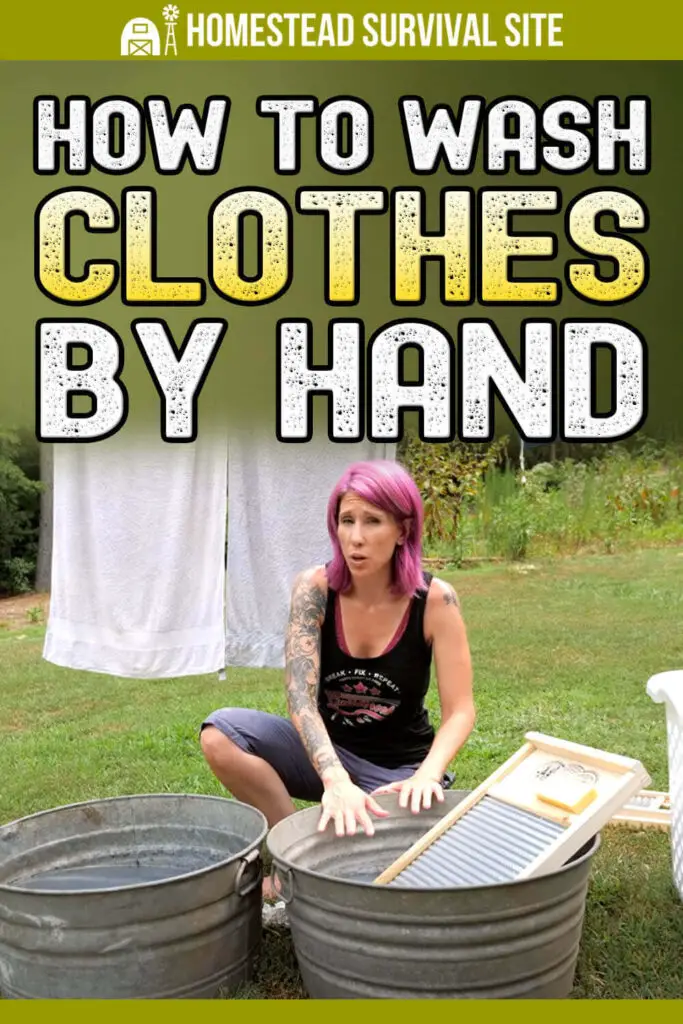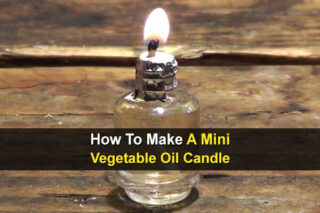Estimated reading time: 5 minutes
If you’re tired of seeing your money and your water supply go down the drain – literally – every time you do laundry, it is time to think about alternative methods for washing and drying your family’s clothes.
In addition to saving energy and water costs, you will discover that washing your clothes by hand will result in cleaner and better-smelling clothes. Let’s look at the different ways you can put your washing machine and dryer into retirement.
Want to save this post for later? Click Here to Pin It On Pinterest!
Washboard and Bucket
This tried and true method is a bit of a workout, but it is easy and inexpensive. Another bonus? It’s pretty good workout!
You will need a large washboard such as the Columbu Family Size Washboard. You’ll also need two or three galvanized wash tubs (large buckets will do in a pinch), a bar of soap, and water. Cold water usually works just fine. Here are the steps for washing with a laundry board.
- Fill the tub up two-thirds of the way water.
- Dip your clothing item into the water to get it wet.
- Rub the bar of soap onto your clothing.
- Now rub the clothing item vigorously on the metal rub surface.
- Repeat the previous steps until it is clean.
- Repeat these steps with the next piece of clothing.
- Dump out dirty water, refill the bucket, and rinse clean items until all soap is gone.
- Wring out your clothes and then hang them on a clothesline to dry.
Wringer Washer
Old-fashioned hand-operated wringer washers are more efficient than the washboard method. You might be able to find a used one in good condition at a thrift store or antique market. If not, there's quite a selection of used models at a variety of price ranges on eBay. Here is a new model if you'd rather not get a used one.
Using a wringer washer is easy. Simply fill the drum with water, add your soap and your clothes, and then do the agitating. Next, place the clothes through the wringer and into the rinse water on the other side. Finally, run the rinsed clothes through the wringer once again to remove excess water out. Then hang your clothing up to dry. Here is a detailed guide.
Plunger
Yes, you can use a plunger for something other than a clogged toilet. For small loads, all you need is a five-gallon bucket with a lid and a new plunger to get started. You can use a regular plunger with a few holes drilled in it, or you can try this one, which is made especially for hand washing clothing.
Now that you have your plunger ready, drill a hole in the center of the bucket's lid. This will allow the plunger handle to stick through. Next, fill the bucket with soapy water and add your clothes.
Place the plunger in the bucket and cover with the lid. Plunge up and down to agitate the clothes. Wring clothes by hand or with a wringer to get out excess water and then use the same procedure for a rinse cycle. Line dry your clean items.
Now that we have looked at some of the timeless methods for handwashing clothes, here are a few newer inventions.
Laundry Pod
Designed for small loads of laundry using little water and no electricity, the Laundry Pod works in the same way a salad spinner does. You add a small amount of water, laundry soap, and your clothes. Then you use your own elbow grease to spin your clothes clean.
Wonder Wash
This portable washer uses a hand crank to clean a five-pound load of laundry in about 5 to 10 minutes. Simply fill it with water, add your dirty items, then turn the crank for agitation. Wring your clothing and line dry.
Drumi
Use your own foot power to operate this small washing machine which was designed to wash a five-pound load in about five minutes. Load soap and dirty clothes into the little washer and power the agitation by pushing the pedal with your foot.
DIY Washers
You can find lots of ideas for building your own hand washer online. Here are a few how-to videos we like.
Homemade Washing Machine
DIY Washing Machine
Bike-Powered Washing Machine
The Dasher Washer
Handwashed clothes tend to be wetter than machine-washed clothes that have gone through a rapid spin cycle. To effectively hand wring, grab each piece firmly and twist your hands away from each other. Wring out large items like sheets or blankets by starting at the top and then moving your hands down each item, wringing the water out lengthwise.
After wringing your clothes, drying them on a clothesline is an easy and inexpensive option, but you may be wondering what to do during inclement weather or if you don’t have much space for a laundry line. Here are a few ideas.
- Basic folding drying rack such as this one.
- Garment rack that allows you to use hangers.
- Umbrella style drying rack.
Clothes will still air-dry during dry days all year round, but you can also use your woodstove to help dry your clothes indoors. Screw basic U-hooks into the walls on either side of the woodstove and run an indoor clothesline between the hooks. The heat from your stove will help dry your clothes on cold and rainy days at no cost to you.
Once you get into the routine of handwashing your family’s laundry, you will discover what system is best for you. Keep in mind that it doesn’t have to be an all or nothing situation. For example, you could handwash small items and use your machine or a laundromat’s machines for large items such as sheets and towels.
What you can be sure of is that you will enjoy the monetary savings and the self-sufficiency of washing your clothes by hand.
Like this post? Don't Forget to Pin It On Pinterest!











All your suggestions are fine but I really like my Lavario Portable clothes washer. It was 139.95 from Amazon. I have had it almost a year and is very easy to use. I set it in my shower, fill the bucket with 5 gals. water and a little bit of liquid detergent. Put the clothes in the basket and push/pull it in the bucket. Wait 10 mins. and push pull again. Wait another 10 mins. and pull the bucket out. Dump the dirty water and refill. Set the basket in the clean water and push pull up and down to clean. Pour out the rinse water, put wet clothes in bottom of bucket and push down on them with the basket. Hang to dry. All very simple and easy, per included instructions.